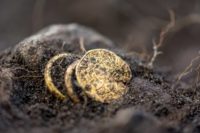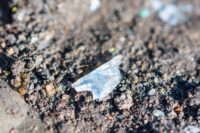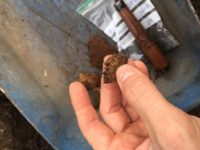 Archaeologists excavating the ringfort of Sandby Borg on the Swedish island of Öland have found two gold finger rings and a Roman gold coin. The three pieces were found nestled together next to large red limestone slab in the remains of a house in the southwest corner of the fort. The rings are small and were probably meant to be worn by a woman which is historically significant because so far no identifiably female human remains have been found at Sandby Borg.
Archaeologists excavating the ringfort of Sandby Borg on the Swedish island of Öland have found two gold finger rings and a Roman gold coin. The three pieces were found nestled together next to large red limestone slab in the remains of a house in the southwest corner of the fort. The rings are small and were probably meant to be worn by a woman which is historically significant because so far no identifiably female human remains have been found at Sandby Borg.
 The gold pieces were found in House 52, an unusual structure that has been the focus of excavations this year. The form of the house differs from the standard rectangle shapes of the other dwellings in the fort. The northern side of it is rounded and centered in the round area is the red limestone slab. Underneath the slab is layer of sand several inches thick. The floor is not this same sand, so that means it was deliberately packed underneath the slab, perhaps to elevate it for some ritual function. Another unique find made only in House 52 is a group of small glass shards. They are very thin, expensive examples of Roman glass and archaeologists think they were part of a small vessel. It’s the only glass that has been found yet in Sandby Borg.
The gold pieces were found in House 52, an unusual structure that has been the focus of excavations this year. The form of the house differs from the standard rectangle shapes of the other dwellings in the fort. The northern side of it is rounded and centered in the round area is the red limestone slab. Underneath the slab is layer of sand several inches thick. The floor is not this same sand, so that means it was deliberately packed underneath the slab, perhaps to elevate it for some ritual function. Another unique find made only in House 52 is a group of small glass shards. They are very thin, expensive examples of Roman glass and archaeologists think they were part of a small vessel. It’s the only glass that has been found yet in Sandby Borg.
“We haven’t found treasure like this before, though we have found jewellery deposits,” Helena Victor, the project leader, told The Local. “It’s always exciting to find gold – the team will always remember this day. It’s also important because we now know a lot more about the house where they were found. It seems to have had a special purpose, and it may have been the house of a chieftain or a minor king.” […]
“This discovery could help explain why the massacre took place – maybe these people had too much gold and jewellery. Archaeology is all about finding out about people, with a very long-term perspective, so we can also compare these finds to violence we see nowadays, and use them to discuss for example why humans are so brutal and hateful,” she added.
 Unlike in the other houses, House 52 has no animal bones. The remains of an elderly man were found there last year — he had been killed and left over the fireplace — and this season the highly fragmented skull of a child was unearthed on the street just to the south of House 52.
Unlike in the other houses, House 52 has no animal bones. The remains of an elderly man were found there last year — he had been killed and left over the fireplace — and this season the highly fragmented skull of a child was unearthed on the street just to the south of House 52.
The coin dates to the reign of the Western Emperor Valentinian III. The obverse bears his image while the reverse depicts the emperor with one foot on the head of a barbarian, a common motif in Roman coinage even in the declining years of the Empire when victories were scarce. Valentinian had Hunnic invasions to deal with as well as constant uprisings in Gaul, Hispania and the Germanic provinces.
The first professional archaeological investigation of the site in 2010, spurred by the appearance of two looting pits, discovered precious metals as well, including gilded silver brooches, buckles, rings and pendants. A gold Roman coin, another solidus of Valentinian III struck around 440-455 A.D., was found the next year in the first full excavation.
It was that first season of digs that revealed the ringfort was destroyed in a violent event in the 5th century A.D. during the turbulent Migration Period. Its thick, high walls were breached, the dwellings within razed and the people slaughtered. Since 2011, excavations have discovered the remains of 26 people, mostly adult men.
This video (Swedish narration only) has some neat footage of the discovery and excavation of the rings and coin: